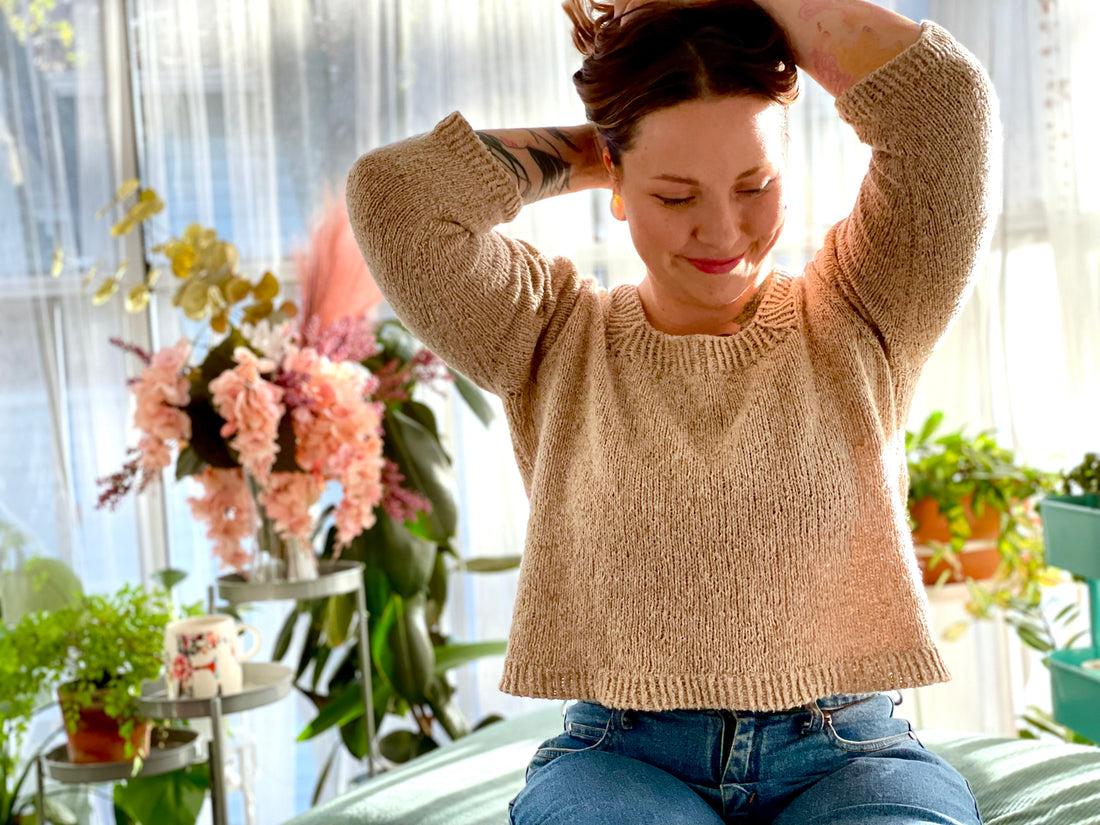
What is sustainable making?
One woman's opinion on a mighty big issue, this week I'm getting in to sustainability and what that means to my making practice. Thank you all so much for engaging in this conversation with me.

The truth is that there is no perfect fiber. Every garment deserves to be worn, and that's what makes it sustainable.
The reason I love knitting tanks and tees is that they replace fast fashion - a sustainable choice with any fiber.
There is no one perfect fiber, but there IS a perfect fiber for each project
At One Wild Designs, one of our biggest values in design is wearability. We believe a garment that gets worn is sustainable. Your garment will be worn most if the fiber you chose works well for the project, and for the wearer!
Instead of comparing yarns to each other, compare them to the choices available from fast fashion.
Have you looked at the labels on most store-bought clothes? If it isn't advertised as a natural fiber, and priced accordingly, nearly all of the clothes out there are synthetic. Additionally, you would be hard pressed to find any clothing for purchase which is truly made with the level of care which we use to make our own clothes. That means they will last longer, be mended, and stay out of landfills far longer than anything you purchase.
If you know me (by the way, it's Elizabeth!), you know I LOVE warm weather knits. One of the reasons I love them so much is that they replace store-bought items in my wardrobe. I wear them all year round as layers, or as the star of the show. It fills me with joy to layer a hand knit tank with my sweatpants all day long while I work away at home. I have never gotten the same kind of joy from a store-bought tank top. Now that I am building a wardrobe of handknit cotton items, I rarely need to purchase those joyless store-bought tanks and tees.
Okay, but of course, there ARE more sustainable fibers
It's a lie to say that superwash yarn has the same carbon footprint as non-superwash. Although, considering the true carbon footprint of a yarn means looking at a lot more than just superwash vs NSW. I am not an expert in climate change, and this whole newsletter has that caveat. However, what I've learned about yarn and fiber I've shared with you here.
Being real about wool
More than Merino
Merino wool is famous and luxurious. In the ready-to-wear market, pure merino wool carries a higher price point and knitters know why. It's decadently soft and feels great against your skin. The fact that so many people can't get enough Merino can bring up an issue. We are losing breeds of sheep whose wool is not prized as highly.
There are many wonderful shepherds and movements around the world to encourage breed diversity. Lately, more and more people are falling in love with Rambouillet, Targhee, Cormo and other breed-specific yarns.
Not all wool is next-to-skin soft, but not all garments truly need to be worn next to your skin. I encourage you to explore some other breeds and see which ones you like. This past year at New York Sheep and Wool there was a wonderful variety of yarns from many breeds and that made my heart sing.
Superwash vs Non-superwash
Most superwash yarns are made with a process that coats the yarn in plastic. There are some superwash yarns out there which do not use plastic in the process but those yarns are rare.
Still, superwash yarn has much less plastic than acrylic yarn. And acrylic blends have much less plastic than the likely 100% plastic fibers that you will buy at any fast fashion retailer.
There are a lot of reasons why superwash might be the right choice for you or your project. There are also a lot of values out there which might be guiding your choices beyond only superwash, as stated above.
What about plant fibers?
You know I love warm weather knits! Listen, this is a bit of a bummer truth, but every fiber out there has its downside when it comes to sustainability. However, there are quite a few lovely plant fibers that will fare better when viewed through this lens.
Organic cotton is one of my favorite fibers to work with. Organic cotton uses less water than non-organic, although cotton's water usage still makes it an imperfect fiber. (I told you they all are). Organic cotton is widely seen as a superior choice. Yarn made with organic cotton isn't cheap, but I have made wonderful and frequent use of the garments I've knit with it. It's machine washable; I even throw my cotton knits in the dryer on low or medium, especially if they've stretched a bit.
Linen is a lovely fiber which is highly sustainable. It can be tougher to knit, but linen fiber becomes super soft the longer you wash and wear it. It's another fiber that can be thrown through the washer and dryer. I've got a linen tank that's been in my wardrobe for about a decade and it's still going strong! Hemp is also widely appreciated as a sustainable fiber, although it's harder to find yarns made with hemp, and I find it knits similarly to linen. Hemp softens over time as well, but not quite the way that linen does.
Bamboo and Tencel are also well-loved sustainable fibers. I find Tencel a wonderful replacement for silk in most cases. Bamboo and Tencel are made from renewable resources and are considered super environmentally friendly.
Recycled yarn is a thing!
There are some wonderful recycled yarns out there. My favorite is Berroco Remix Light. These yarns are typically a blend of fibers, including recycled plastic in some cases. One of the things I love about recycled yarns is that they are typically also quite affordable.
My cropped Hypatia Pullover, pictured below, is knit with Berroco Remix Light in the color Oatmeal. I do not love acrylic generally, but this blend of many recycled fibers feels like a very light wool or cotton.

In the end, making is sustainable
As I've said, there are many reasons you will choose the yarn you create with. Because you can afford it, because you know it will make a functional finished object, because it's local, because you support the indie dyer who sells it, because you love it.
Be proud of your makes.
Be proud of yourself.
Make the choices that will create a finished object you love and can use. Use the thing you make.
Making something useful with your own hands is sustainable.
I love that for you.
